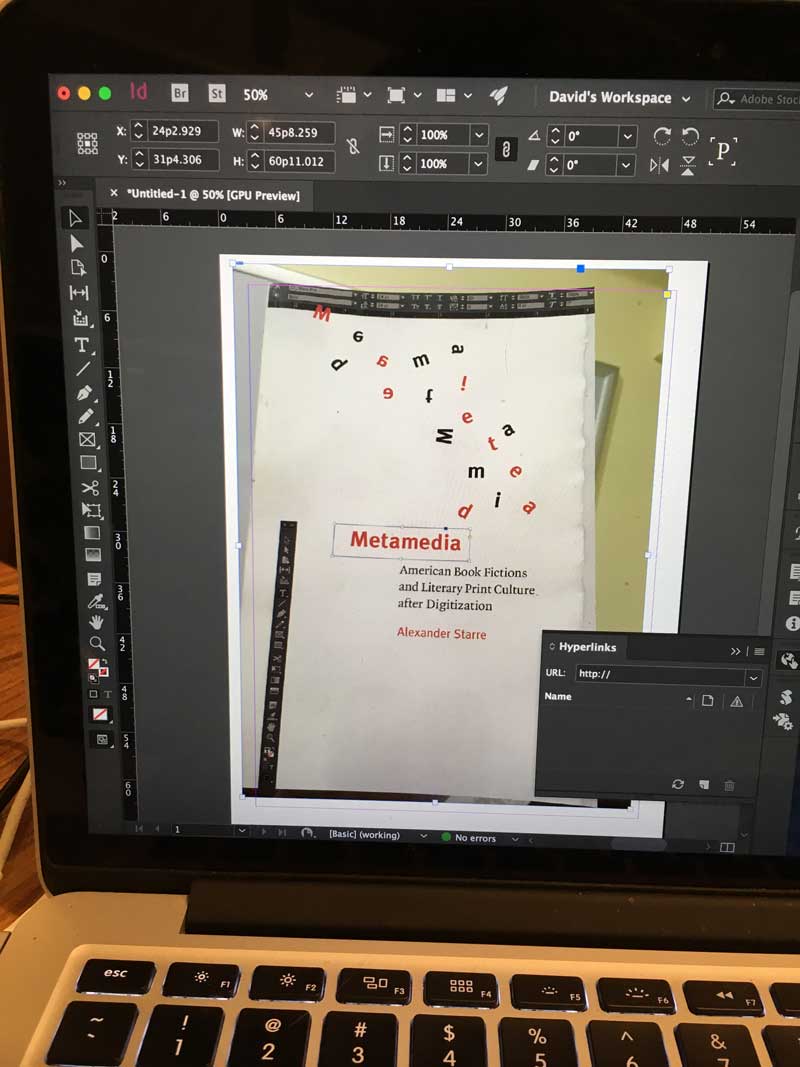Metamedia: A Book with InDesign on its Cover
Can you judge a book by its cover? After all, first impressions are often right… right? So when I picked up the book Metamedia, I knew I had a winner in my hands. After all, the cover literally displays user-interface elements of Adobe InDesign: the Tools panel and the Control panel (set, of course, to character formatting mode).

Is this “meta” enough for you?
Whatever the topic, the cover art tells us that the book must be amazing!
Sadly, Metamedia has nothing to do with InDesign. It’s a deeply academic treatise on the nature of literature in a time of electronic texts. OK, the word InDesign does appear three times in the book (according to the index), but in each case it is a side note, almost incidental—as though any other page-layout software could be inserted just as easily. InDesign is not the central protagonist of this story! The author apparently has some other agenda, involving phrases such as “paratextual framing” (no, nothing to do with graphic or text frames) and “the dialectic of digitization” (which I’m quite sure does not appear in any InDesign menu).
That said, the cover design (which I assume was created by the same person who designed the interior, Sara Sauers) is wonderfully “meta” media itself… not only is the title set in the font “Meta Pro” but the Control panel at the top of the cover shows it:

While this book may interest doctoral students and other masochists, it will not help you master InDesign or provide the sorts of insights into the mysteries of the Tool and Control panels that you may have become accustomed to by reading articles here at InDesignSecrets.
The book is Metamedia: American Book Fictions and Literary Culture after Digitization by Alexander Starre, published by University of Iowa Press.




I realized that first photo is a little confusing, so just to be clear: this is a photo of an InDesign document in which I’ve placed a photo of the book. Careful: If you take a picture of this photo on your screen, it may generate a feedback loop that kills the internet.
Nice to see you took the meta-photo on a wooden table.
Sorry, wrong forum (thedailywtf)
Quote: “The author apparently has some other agenda, involving phrases such as “paratextual framing” (no, nothing to do with graphic or text frames) and “the dialectic of digitization” (which I’m quite sure does not appear in any InDesign menu).”
Ah, you’ve discovered the wonders of today’s social-science academia—meaningless ideas described with jargonistic terms in tangled, unreadable sentences. That’s best illustrated by the Sokal affair.
“Sokal reasoned that, if the presumption of editorial laziness was correct, the nonsensical content of his article would be irrelevant to whether the editors would publish it. What would matter would be ideologic obsequiousness, fawning references to deconstructionist writers, and sufficient quantities of the appropriate jargon.”
https://en.wikipedia.org/wiki/Sokal_affair
And sadly, students—even those who major in legitimate subjects—are spending years getting out of college debts that funded such madness.
Well, to be fair, while there is a lot of bad writing out there, I think it appears across disciplines. Plus, academia has its own language, much like we do… why use the confusing and obscure word “leading” when you could write “the amount of space between the baseline of one line in a paragraph and the previous line.” ;-)
My guess it that for people who live and breathe that academic language, it makes sense.
That said, the post-modern contextualizing of InDesign in a broad para-digi-analogistic paradigm will nevertheless antithicate any nonsensical quasi-amanuenstic thought/action catharsis. Obviously.
This book is actually fairly jargon free and doesn’t masquarade in whatever poststructurtalist lingo you seem to garnish it with. The book is however trying to estbalish some terms to talk about recent developments in book design and literary fiction. It’s textual scholarship, hence the term paratextual, which has a very uncomplicated definition. If you encounter a word you’ve never read before in a physics book, do you say, fuck these guys, they don’t know anything about physics? I hope not. The anti-intellectualism of such a response is far worse than whatever charge Starre would be guilty of. Starre’s book is good, highly readable, insightful, and contributes to contemporary textual and literary scholarship. A reference to Sokal here is more a sign of how many red pills you’ve swallowed than anything else.
Your article is smile-worthy David.
The cover feels like a communication mistake i.e.
SALES REP: We need to print this job NOW! Has the client approved the cover yet?
PREPRESS: Not yet.
SALES REP: We can’t wait any longer, just print out what you have on-screen and we’ll deal with it later.
PREPRESS: Seriously?
SALES REP: I’ll sign it off, just do it! What you have on your screen looks fine!
LOL!!